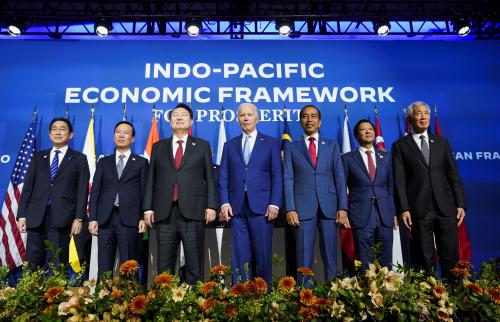Summary
On September 20, as many as 150 million voters in Indonesia—the world’s fourth most populous nation—will directly elect their country’s president for the first time since independence in 1945. Indonesia is also the world’s largest majority-Muslim country. With comparable turnouts in parliamentary elections in April and a first-round presidential election in July, Indonesia is close to concluding the three biggest one-day votes in recorded history. Despite predictions of terrorist acts and electoral violence, the September vote is likely to be peaceful. More significantly, the political and economic transitions occurring in Indonesia this year reflect a remarkable effort to create strong foundations for good governance and sustainable economic growth in the coming years.
The presidential contenders are incumbent President Megawati Sukarnoputri, the eldest daughter of Indonesia’s flamboyant first president, and Susilo Bambang Yudhyono, a former army general dismissed from Megawati’s cabinet in February when he persisted in campaigning for the presidency. The outcome is unpredictable because the voters in the two earlier elections exhibited an exceptional degree of independence.
The significance of a smooth political transition in Indonesia this year cannot be overemphasized. Political succession has been a major challenge for Asian countries since World War II and it remains a burning issue in the Muslim heartland of the Middle East. There have been three rough transitions in Indonesia in the past seven years. In 1998, General Suharto lost his grip on power after 30 years of iron rule and resigned in favor of vice president Habibie. In 1999, Abdurrahman Wahid outmaneuvered Megawati to claim the presidency in the indirect balloting that followed Indonesia’s first democratic election since the mid-1950s. Megawati accepted the vice presidency even though her party won the largest number of seats in the new parliament. Megawati then assumed the presidency in 2001 through a messy and constitutionally questionable process when Wahid’s erratic leadership cost him the support of the coalition that had made him the nation’s leader.
News reports about Indonesia in recent years have featured terrorism, regional insurgencies, and human rights abuses. They have glossed over a quiet revolution that holds out the prospect of restoring a sense of well being to a country that lost its way in a financial crisis in 1997.
At the heart of this revolution is a set of constitutional amendments adopted after 1998 that create a political system with much stronger checks and balances. In addition to the direct election of the president, the amendments establish a new “senate” and a new constitutional court. At the beginning of 1991, Indonesia also implemented one of the most radical decentralizations of power the world has seen, transferring substantial authority and responsibility from the central government to the country’s 349 kabupaten (districts) and 91 kota (cities).
Progress on the political front has been reinforced by stronger macroeconomic management than most analysts expected when Megawati became president. Inflation has fallen from 12 percent to 5 percent. The benchmark interest rate has dropped from 17 percent to 7 percent. Foreign exchange reserves have risen while the rupiah has appreciated in real effective terms. Despite the risks in an election year, Indonesia has also stopped borrowing from the IMF and obtaining debt relief from its foreign creditors. Its return to creditworthiness was signaled by a $1 billion international bond issue successfully floated in March.
The platforms of Megawati and Susilo Bambang Yudhyono are similar, which means that Indonesia’s basic policy directions are unlikely to change much when the new government takes office at the end of October. Even with a strong mandate, however, the country’s leadership will still face daunting political and economic challenges. In the political arena, a workable formula for power sharing between the president, the cabinet, the two houses of parliament, and the regions will have to be found. This effort will be complicated because a new generation of politicians will be competing for leadership positions in the five main political parties, because the armed forces will be adjusting to a diminished role in the country’s political and economic life, and because deep-rooted ethnic tensions persist in Aceh, Papua, and several other hot spots.
In the economic arena, the sense of malaise is palpable. Macroeconomic stability has not been enough to push the GDP growth rate back to levels above 5 percent level, the pace achieved through most of the Suharto era. Institutional obstacles have held back the domestic and foreign investment required to keep unemployment from growing. Progress under the next government will depend on making the judicial system more reliable, strengthening the banking system, and turning the corner on corruption. Much of the necessary groundwork is in place, however, and Indonesia may not be far from a tipping point at which the reform process and business confidence become mutually reinforcing.
Still it is worth bearing in mind that Indonesia’s first experiment in constitutional democracy failed in 1957 after seven years of political bickering. If the next government is unable to gain more domestic support and international credibility than the current government, Indonesia’s political and economic transitions could stall and slip into reverse.



Commentary
Indonesia’s Quiet Revolution
September 1, 2004